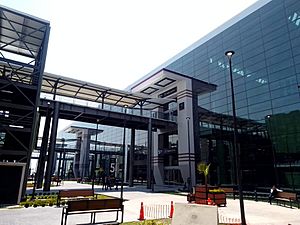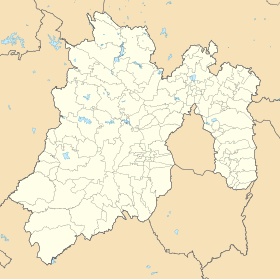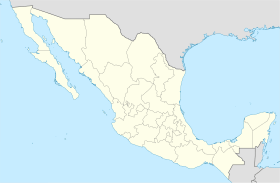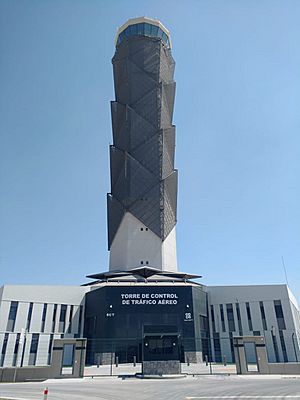Felipe Ángeles International Airport facts for kids
Quick facts for kids
Felipe Ángeles International Airport
 Aeropuerto Internacional Felipe Ángeles
|
|||||||||||||||||||
|---|---|---|---|---|---|---|---|---|---|---|---|---|---|---|---|---|---|---|---|

Terminal view
|
|||||||||||||||||||
| Summary | |||||||||||||||||||
| Airport type | Public | ||||||||||||||||||
| Owner | Mexican Government | ||||||||||||||||||
| Operator | SEDENA | ||||||||||||||||||
| Serves | State of Mexico / Mexico City | ||||||||||||||||||
| Location | Santa Lucía, Zumpango, State of Mexico, Mexico | ||||||||||||||||||
| Opened | 21 March 2022 | ||||||||||||||||||
| Coordinates | 19°45′24″N 099°00′55″W / 19.75667°N 99.01528°W | ||||||||||||||||||
| Website | |||||||||||||||||||
| Map | |||||||||||||||||||
| Runway | |||||||||||||||||||
|
|||||||||||||||||||
| Statistics (2022) | |||||||||||||||||||
|
|||||||||||||||||||
|
Sources: MEX, STV,
|
|||||||||||||||||||
Felipe Ángeles International Airport (in Spanish: Aeropuerto Internacional Felipe Ángeles), also known as AIFA, is a major airport serving the Mexico City metropolitan area. It opened on March 21, 2022. The airport is located in Zumpango, State of Mexico, about 49 kilometers (30 miles) north of the center of Mexico City.
This airport was originally a military base called Santa Lucía Airport. It was later renamed after Felipe Ángeles, a famous general from the Mexican Revolution. The Mexican Government owns the airport, and the Secretariat of National Defense (SEDENA), which is part of the army, operates it. AIFA is the largest airport in the State of Mexico and the second largest in the country by land size.
Contents
Airport History
Early Days of Santa Lucía Air Base
The Santa Lucía Air Base first opened in 1952. It was built because the older military air field in Balbuena needed to be moved. The new air base had a very long runway, 3,780 meters (about 2.3 miles) long and 75 meters (about 246 feet) wide. This was the widest paved runway in Mexico at the time.
Why a New Airport Was Needed
For a long time, Mexico City's main airport was very busy. There was a plan to build a new, much larger airport in Texcoco. However, in 2018, the future president, Andrés Manuel López Obrador, suggested a different idea. He proposed either finishing the Texcoco airport or expanding the Santa Lucía military base to become a civilian airport. He decided to go with the Santa Lucía plan.
A public survey was held to ask people what they preferred. Most people who voted chose to build the new airport at Santa Lucía.
Building the Airport
Construction of the Felipe Ángeles International Airport officially began on October 17, 2019. The plan was to build two new runways and a new main terminal building. This first part of the project was finished on time, by March 21, 2022.
The airport was designed to help reduce crowding at Mexico City International Airport. It was also planned to focus on low-cost airlines (which offer cheaper flights) and cargo airlines (which carry goods instead of people).
During construction, something amazing was found: the remains of at least 200 mammoths! These ancient animals likely got stuck in mud in the old Lake Xaltocan, where the airport was being built. Finding these remains did not stop the airport's construction.
The airport officially opened with its first commercial passenger flight on March 21, 2022.
Getting to the Airport
Currently, the main way to get to AIFA is by road. However, there are plans to make it easier to reach.
Future Train Connection
A new train line is being built to connect the airport to Mexico City. This will be an extension of the Tren Suburbano (suburban train) network. It will branch off from the Lechería station and go directly to the airport. This train line is expected to open in 2024.
Roads and Bus Services
Several new roads and improvements to existing highways have been made to connect to AIFA. One important road connects the airport to the Circuito Exterior Mexiquense, a major highway around Mexico City. This road has special lanes for easy travel and even features sculptures of mammoths!
There are also bus services that connect AIFA to different parts of Mexico City and other cities.
- The Mexibús system has a line that connects the airport to the Mexico City subway system.
- Other bus companies offer connections from major bus terminals in Mexico City and other cities like Querétaro.
Airlines and Destinations
Passenger Flights
Many airlines fly passengers to and from Felipe Ángeles International Airport. You can fly to various cities within Mexico and some international destinations.
| Airlines | Destinations |
|---|---|
| Aeroméxico | Cancún, Guadalajara |
| Aeroméxico Connect | Acapulco, Houston–Intercontinental, Mérida, Monterrey, Oaxaca, Puerto Vallarta, Veracruz |
| Arajet | Santo Domingo–Las Américas |
| Conviasa | Caracas |
| Copa Airlines | Panama City–Tocumen |
| Magnicharters | Havana |
| Viva Aerobus | Acapulco, Cancún, Havana, Hermosillo, Ixtapa/Zihuatanejo, Mazatlán, Monterrey, Oaxaca, Puerto Escondido, Puerto Vallarta, Tijuana |
| Volaris | Cancún, Ciudad Juárez, Culiacán, Guadalajara, Huatulco, La Paz, Mérida, Mexicali, Oaxaca, Puerto Escondido, Puerto Vallarta, San José del Cabo, Tijuana |
Cargo Flights
AIFA is also an important hub for cargo flights, which transport goods around the world. Many cargo airlines use this airport. In 2023, all cargo operations from Mexico City's older airport were moved to AIFA.
| Airlines | Destinations |
|---|---|
| AeroUnion | Los Angeles, Tijuana |
| Air Canada Cargo | Guadalajara, Toronto–Pearson |
| Air France Cargo | Paris–Charles de Gaulle |
| Atlas Air | Anchorage, Chicago–O'Hare, Liege |
| Awesome Cargo | National |
| Cargojet | Cincinnati, Guadalajara |
| Cargolux | Anchorage, Luxemburg, Portland (OR) |
| Cathay Cargo | Anchorage, Guadalajara |
| China Southern Cargo | Harbin, Los Angeles, Shanghai–Pudong, Shenzhen |
| DHL Aviation | Cincinnati |
| Emirates SkyCargo | Frankfurt, Quito, Zaragoza |
| Estafeta | Miami, San Luis Potosí |
| Ethiopian Airlines Cargo | Spain |
| Lufthansa Cargo | Dallas/Fort Worth, Guadalajara, Frankfurt |
| Mas Air | Zhengzhou |
| MSC Air Cargo | Anchorage, Indianapolis, Liege |
| National Airlines Cargo | Anchorage, Campinas, Miami |
| Qatar Airways Cargo | Bogotá, Los Angeles |
| Turkish Cargo | Chicago–O'Hare |
Airport Statistics
Busiest Routes in 2022
This table shows the busiest flight routes from Felipe Ángeles International Airport in 2022.
| Rank | City | Passengers | Ranking | Airline |
|---|---|---|---|---|
| 1 | 117,160 | Aeroméxico, VivaAerobús, Volaris | ||
| 2 | 68,045 | Aeroméxico, VivaAerobús, Volaris | ||
| 3 | 53,114 | Aeroméxico Connect, VivaAerobús, Volaris | ||
| 4 | 47,309 | VivaAerobús, Volaris | ||
| 5 | 42,181 | Aeroméxico Connect, Volaris | ||
| 6 | 24,977 | Aeroméxico Connect, Volaris | ||
| 7 | 20,220 | Volaris | ||
| 8 | 18,058 | Aeroméxico Connect, VivaAerobús, Volaris | ||
| 9 | 11,472 | VivaAerobús, Volaris | ||
| 10 | 11,021 | Aeroméxico Connect, VivaAerobús | ||
| 11 | 8,247 | Volaris | ||
| 12 | 7,124 | Volaris | ||
| 13 | 6,876 | Volaris | ||
| 14 | 5,449 | Aeroméxico Connect | ||
| 15 | 5,094 | Copa Airlines |
See also
 In Spanish: Aeropuerto Internacional Felipe Ángeles para niños
In Spanish: Aeropuerto Internacional Felipe Ángeles para niños
- Mexico City International Airport
- Transportation in Mexico
- Transport in Mexico City




